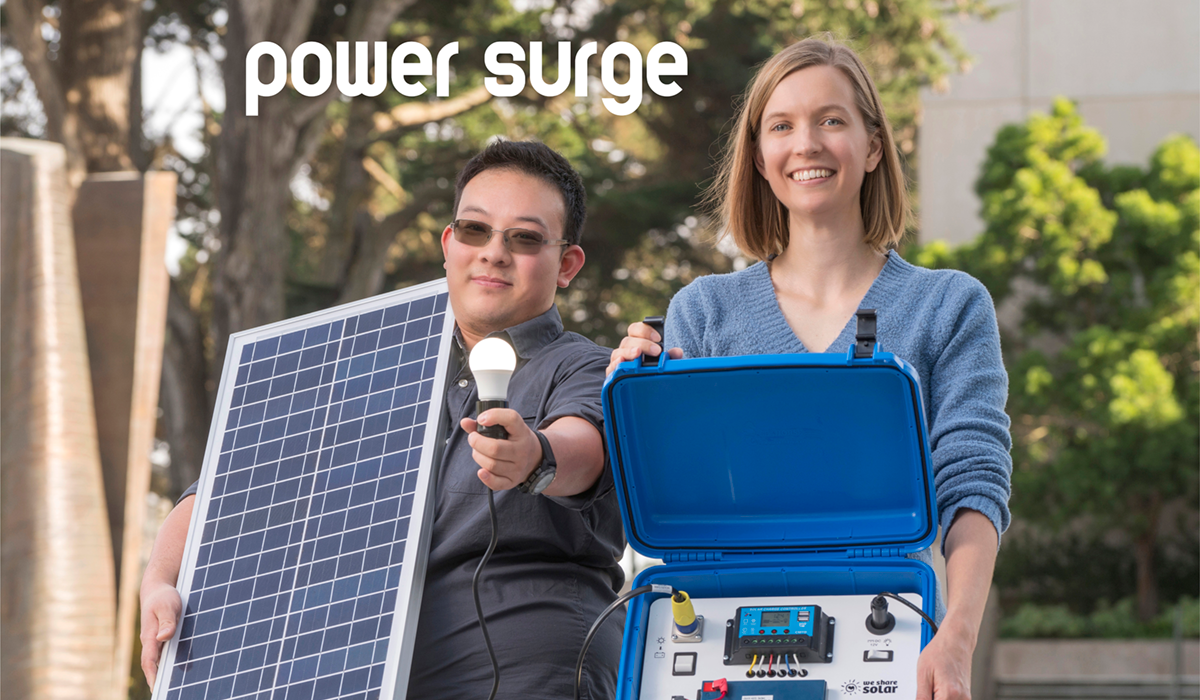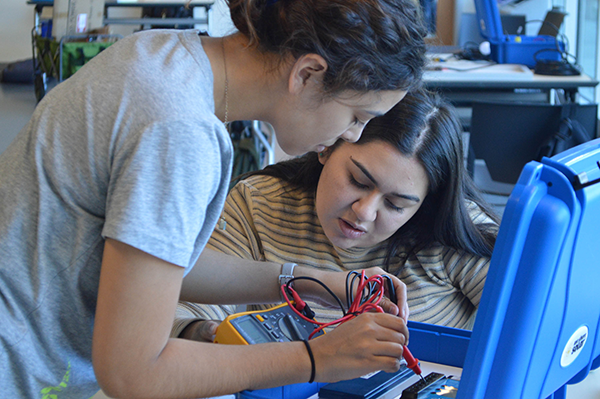‘Solar suitcases’ deliver hands-on experience to an environmental justice course

Environmental Studies student Jin Zhu and Assistant Professor Autumn Thoyre with one of the solar suitcases (Photo by Jim Block)
In a conference room at a Stockton training center last July, Daly City middle school teacher Leland Oshins learned how to connect the wires, ports and circuits in a portable solar-power kit and reviewed materials that would help teach his students about electricity. He and about 20 fellow trainees also learned that the innovative educational program We Share Solar, an arm of the nonprofit We Care Solar, would send the assembled “solar suitcases” to remote schools, orphanages and refugee centers across the developing world, where they’d help meet critical needs like powering medical equipment, lights and water purifiers. Oshins left the training inspired.
“I hadn’t realized that the project was reaching into the classroom but also reaching beyond the classroom,” he says — teaching the kids about energy but also actually bringing power to developing countries.
Unfortunately, back at Thomas R. Pollicita Middle School, the logistics weren’t adding up. Oshins had 11 of the blue teaching suitcases and 180 students — five sixth-grade classes and one seventh grade. He felt deflated. “I’m not going to be able to teach all of my kids all these complicated instructions,” he remembers thinking. Unable to find support, he was ready to give up.
But during a last-ditch call to We Share Solar, his liaison told him that a professor at San Francisco State had just gotten involved in the program — maybe she’d have an idea. He shot her an email, and indeed, Autumn Thoyre, an environmental studies faculty member in the School of Public Affairs & Civic Engagement, confirmed that she’d be training her students to lead the classroom project. Could she send them over to help him out?
“I was like, ‘Yes, please!’” recounts Oshins, who is currently earning his regular teaching credential at SF State while teaching full-time as an intern at Pollicita. After that, he says, all the pieces came together. “It just felt like kismet.”
The partnership crystalized the solar suitcase project’s expansion to SF State. Launched in 2015 as a pilot at Cal State East Bay, the service-learning program gives CSU students training in solar suitcase assembly, then dispatches them to local middle and high schools to provide hands-on classroom guidance. The outcomes are richly layered: undergraduates get both service-learning and science-teaching experience; community schools get a meaningful, hands-on science project; and University faculty get an exciting, well-supported project around which they can develop their own curricula.
New course, new direction
“It’s the kind of project that as an environmental studies professor, it’s really hard to pass up,” says Thoyre, who joined the College of Health & Social Sciences’ faculty in Fall 2016. After completing her first year, she was prepping a new Fall ’17 course when Karina Garbesi, the director of Cal State East Bay’s successful solar suitcase pilot, contacted her about including SF State in an expansion of the project. Thoyre had already organized her newly approved Energy Justice and Sustainability (ENVS 460) course around a different project, but she started rejiggering almost immediately. “Within a week I’d said, ‘I’m on board,’” she remembers.
“I wanted a course that would think about energy systems in the context of environmental justice,” says Thoyre, whose research is on energy policy and climate-change activist groups. She adjusted her curriculum to unify the suitcase initiative with her project “People’s Guide to Energy,” in which her students’ research on energy injustice sites is organized geographically on an interactive map. The connection was natural — one activity analyzes a problem and one develops a solution, she says.
Each training suitcase contains a booklet with step-by step instructions designed for middle school-level and up. There are interactive “Check for understanding” interludes to teach students about electricity while they assemble the apparatus and connect it to a solar cell that lives outside the case. The kit even comes with an LED bulb for testing the assembled power source.
The program, which partners with PG&E, added four additional CSUs this academic year. But the others are all based in physics classes. One of the benefits of the social science lens, Thoyre says, is that she can push her students to analyze renewable energy from a societal perspective — what problems does it solve, and what does it perpetuate? They explore gray areas like who has control over resources and what that means.
“Sometimes so-called ‘clean’ energy has problems,” she says. “If a project isn’t perfect, how do they make it better?”
Lighting up the classroom
In implementation mode at Pollicita, Oshins splits up his classes into small groups, posting one of Thoyre’s students at each one. By the end of two weeks, all 180 kids had built the suitcases from start to finish. Some kids even got an extra turn.
“They got really good with it. They could put this thing together in under an hour,” Oshins says.
He was especially gratified to see that hands-on building was a way for students who were not as strong at more traditional classroom activities to excel. One of his seventh-graders, Rafat, had trouble focusing and often acted out in class. “He gets yelled at a lot,” Oshins confesses. But Rafat quickly connected with his SF State mentor, Nathan Wong, and with the project itself.
“Rafat just nailed it. He worked his way through the build in no time at all, and was just so excited,” Oshins says. “I wish I could have taken a picture of his face — you could see how ecstatic he was to build something with his own hands, to really figure it out. He wanted to build it again — he was upset when the period ended.”
Thoyre’s students created a lot of moments like that, Oshins says. “In a relatively short amount of time, maybe 40 minutes, they were able to accomplish something really big for these kids.”
The project’s social dimensions go deeper than just different learning styles. We Share Solar originally designed the project to engage students from underrepresented groups — students of color, from low-income or immigrant families, and females — in science, technology, engineering and math (STEM) fields. Students who get involved in science projects with a social justice component are more likely to get interested and stay interested, Thoyre says, citing a growing body of research.
And the culturally diverse middle-schoolers, many of them from working class, low-income or immigrant homes, saw role models in the SF State students. “There’s power in having college students from the same socioeconomic background as the classroom kids share their passion and show what it’s possible to achieve,” she says.

SF State students Katya Amezcua (left) and LisaMarie Betancourt use a digital multimeter to test the circuit on the solar suitcase they have just built. (Photo by Ernita Joaquin)
Reaching further into the community
Jin Zhu worked late the night before his scheduled visit to Oshins’ classroom, slept through his alarm, and missed the session. He was crushed. The environmental studies major, a newly transferred junior from Skyline Community College, has a passion for the suitcase project, including working with kids.
As a San Francisco native whose parents emigrated from Hunan Province to work in his grandfather’s Chinese restaurant chain, Zhu understands the value of his presence for some of the school kids. He was the first in his family to go to college, and hadn’t had a lot of role models or parental coaching to suggest careers outside the restaurant arena.
“Basically my parents just said, ‘Anything but restaurant work. Find a good civil service job so you can make a living,’” Zhu says. But college and the enthusiasm of his professors, including Thoyre, were opening his eyes more rewarding possibilities.
Determined to make up the fieldwork, Zhu used his own connections, did his own outreach, and brought the project to third graders at Boys and Girls Clubs in both Millbrae and San Bruno. His ingenuity also rescued a few of his classmates who’d missed their teaching day, and together with this SF State posse, he delivered a customized training, devising age-appropriate examples to teach electricity basics. His piece de resistance was a fart-based explanation on how electrons flow. He also included the social justice component.
“I wanted them to see their own privilege compared to kids in developing countries,” he says. He gave them examples of what energy is used for that they could easily understand — like seeing in the dark to remove a painful splinter or finish homework — “And then I emphasized: People don’t all have the same stuff you guys do.”
The kids loved it. “When they plugged in the light bulb, they were like, ‘Oh my god, we did it! That’s so cool!’” Zhu recounts. He especially loved how they took basic concepts and ran with them, asking questions like “Can moonlight charge it?” They wanted to show their families, and one girl asked to bring the suitcase overseas herself, “so that she could ‘see the people over there using it,” Zhu says. “It was really heartwarming.”
Like Oshins, Zhu observed that some of the kids who’d been labeled troublemakers were exceling in the hands-on activity. “So I told them, ‘If you want to do this in the future, there are jobs like this, where you put things together, and it’s an awesome job.’”
Switching on new ideas
Zhu is hooked. He plans to do more solar suitcase visits with the Boys and Girls Club. Encouraged by Thoyre’s support, he’s considering customizing an internship around his efforts, and is even eying a teaching career.
The project has also altered Thoyre’s academic trajectory, accelerating her timeline for incorporating service learning into her classes. She’s considering turning ENVS 460 into a service-learning class, and that idea is percolating up other possibilities, like training students to do simple energy audits, then sending them into the field to help low-income households find savings. “They’d learn some practical skills but also make a difference,” she says.
For now, Thoyre looks forward to hearing from We Share Solar about where last semester’s suitcases landed, to cement the value of the class.
Going even broader, Thoyre points to the powerful symbolism that even a middle-schooler can build a solar suitcase. A lot of her students arrive with a preconception that renewable energy isn’t used more because the technology isn’t far enough along, she says. “Once you demystify the engineering aspect of solar energy, it puts the focus back on policies and economics and social norms and those larger question of what kind of energy systems we’re using.”
Tags